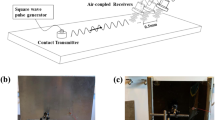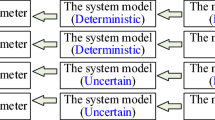Abstract
A novel method is suggested to deal with so-called uncertainty inverse problems (UIPs) which are a class of inverse problems with uncertainty in the system parameters of the forward model. Interval which represents a closed bounded set of real numbers is used to model and characterize the uncertainty in our formulation, and hence only the bounds of the uncertainty of the system parameters are needed. For a specific input vector, the possible values of the outputs form an interval vector because of the uncertainty. An error function is defined using the measured interval vector of the outputs and those computed using a forward model. The UIP is then formulated as an optimization problem which minimizes the error function. To improve the optimization efficiency, an interval forward model is constructed based on the interval analysis method which can calculate very efficiently the bounds of the outputs caused by the uncertainty of the system parameters. The present method is applied to a complex inverse problem, namely material characterization of composite laminates using elastic waves. Uncertainty of load is considered, and the hybrid numerical method (HNM) is used to compute the transient displacement responses. The engineering constants of two kinds of laminates are successfully identified using the simulated measurements of the outputs.






Similar content being viewed by others
References
Tarantola A (1987) Inverse problem theory. Elsevier Science, The Netherlands.
Kubo S (ed) (1992) Inverse problems. Atlanta Technology Publications, Atlanta.
Santamarina JC, Fratta D (1998) Introduction to discrete signals and inverse problems in civil engineering. ACES, Reston.
Engl HW, Hanke M, Neubauer A (2000) Regularization of inverse problems. Kluwer, The Netherlands.
Liu GR, Han X (2003) Computational inverse techniques in nondestructive evaluation. CRC, Florida.
Liu GR, Han X, Xu YG, Lam KY (2001) Material characterization of functionally graded material by means of elastic waves and a progressive-learning neural network. Compos Sci Technol 61:1401–1411.
Charnes A, Cooper WW (1959) Chance-constrained programming. Manage Sci 6:73–79.
Kall P (1982) Stochastic programming. Eur J Oper Res 10:125–130.
Liu B, Iwamura K (1997) Modelling stochastic decision systems using dependent-chance programming. Eur J Oper Res 101(1):193–203.
Liu BD, Zhao RQ, Wang G (2003) Uncertain programming with applications. Tsinghua University Press, Beijing, China.
Abbas M, Bellahcene F (2006) Cutting plane method for multiple objective stochastic integer linear programming. Eur J Oper Res 168(3):967–984.
Ben-Haim Y, Elishakoff I (1990) Convex models of uncertainties in applied mechanics. Elsevier Science, Amsterdam.
Moore RE (1979) Methods and applications of interval analysis. Prentice-Hall, London.
Kreinovich V, Beck J, Ferregut C, Sanchez A, Keller GR, Averill M, Starks SA (2007) Monte-Carlo-type techniques for processing interval uncertainty, and their potential engineering applications. Reliab Comput 13(1):25–69.
Jerrell ME (1997) Interval arithmetic for input–output models with inexact data. Comput Econ 10(1):89–100.
Braems I, Ramdani N, Boudenne A, Kieffer M, Jaulin L, Ibos L, Walter E, Candau Y (2005) New set-membership techniques for parameter estimation in presence of model uncertainty. Proceedings of the 5th International Conference on Inverse Problems in Engineering: Theory and Practice, B09, Cambridge, UK.
Tanaka H, Ukuda T, Asal K (1984) On fuzzy mathematical programming. J Cybern 3:37–46.
Ishibuchi H, Tanaka H (1990) Multiobjective programming in optimization of the interval objective function. Eur J Oper Res 48:219–225.
Rommelfanger H (1989) Linear programming with fuzzy objective. Fuzzy Sets Syst 29:31–48.
Liu XW, Da QL (1999) A satisfactory solution for interval number linear programming. J Syst Eng 14:123–128 (China).
Sengupta A, Pal TK, Chakraborty D (2001) Interpretation of inequality constraints involving interval coefficients and a solution to interval linear programming. Fuzzy Sets Syst 119:129–138.
Ma LH (2002) Research on method and application of robust optimization for uncertain system. Ph.D. thesis, Zhejiang University, China.
Jiang C, Han X, Liu GR, Li GY (2007) The optimization of the variable binder force in U-shaped forming with uncertain friction coefficient. J Mater Process Technol 182:262–267.
Jiang C, Han X, Guan FJ (2006) A nonlinear structural optimization method based on interval description of uncertainty. The Fourth China–Japan–Korea Joint Symposium on Optimization of Structural and Mechanical Systems, Kunming, China, pp 347–352.
Jiang C, Han X, Guan FJ, Li YH (2007) An uncertain structural optimization method based on nonlinear interval number programming and interval analysis method. Engineering Structures DOI 10.1016/j.engstruct.2007.01.020.
Liu GR, Tani J, Ohyoshi T, Watanabe K (1991) Transient waves in anisotropic laminated plates, part1: theory. J Vib Acoust 113:230–234.
Liu GR, Tani J, Ohyoshi T, Watanabe K (1991) Transient waves in anisotropic laminated plates, part1: theory; part2: application. J Vib Acoust 113:235–239.
Liu GR, Lam KY, Tani J (1995) An exact method for analyzing elastodynamic responses of anisotropic laminates to line loads. Mech Compos Mater Struct 2:227–241.
Liu GR, Lam KY, Ohyoshi T (1997) A technique for analyzing elastodynamic responses of anisotropic laminated plates to line loads. Compos B Eng 28B:667–677.
Liu GR, Xi ZC (2002) Elastic waves in anisotropic laminates. CRC Press, Florida.
Xu YG, Liu GR, Wu ZP (2001) A novel hybrid genetic algorithm using local optimizer based on heuristic pattern move. Appl Artif Intell 15(7):601–631.
Qiu ZP, Wang XJ (2003) Comparison of dynamic response of structures with uncertain non-probabilistic interval analysis method and probabilistic approach. Int J Solids Struct 40:5423–5439.
Haftka RT, Gurdal Z (1992) Elements of structural optimization. Kluwer, The Netherlands.
Liu GR, Ma WB, Han X (2002) An inverse procedure for determination of material constants of composite laminates using elastic waves. Comput Methods Appl Mech Eng 191:3543–3554.
Han X, Liu GR (2003) Computational inverse technique for material characterization of functionally graded materials. AIAA J 41(2):288–295.
Waas G (1972) Linear two-dimensional analysis of soil dynamics problems in semi-infinite layer media. Ph.D. thesis, University of California, Berkeley, CA.
Nelson RB, Dong SB, Kalra RD (1971) Vibrations and waves in laminated orthotropic circular cylinders. J Sound Vib 18:429.
Kausel E (1986) Wave propagation in anisotropic layered media. Int J Numer Methods Eng 23:1567.
Han X, Jiang C, Huang YH (2006) Transient waves in composite laminated plates with uncertain load and material property. Int J Numer Methods Eng (in press).
Kendall MG, Stuart A (1969) The advanced theory of statistics. Griffin, London.
D’Cruz J, Crisp JDC, Ryall TG (1992) On the identification of a harmonic force on a viscoelastic plate from response data. J Appl Mech–T ASME 59:722–729.
Acknowledgements
This work is supported by the national 973 program under the Grant No. 2004CB719402, the program for Century Excellent Talents in University (NCET-04-0766), the National Natural Science Foundation of China (10572048) and the National Science Fund for Distinguished Young Scholars (50625519).
Author information
Authors and Affiliations
Corresponding author
Rights and permissions
About this article
Cite this article
Jiang, C., Liu, G.R. & Han, X. A Novel Method for Uncertainty Inverse Problems and Application to Material Characterization of Composites. Exp Mech 48, 539–548 (2008). https://doi.org/10.1007/s11340-007-9081-5
Received:
Accepted:
Published:
Issue Date:
DOI: https://doi.org/10.1007/s11340-007-9081-5




